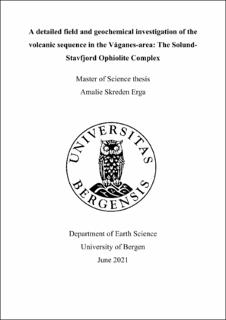A detailed field and geochemical investigation of the volcanic sequence in the Våganes-area: The Solund-Stavfjord Ophiolite Complex
Master thesis
Permanent lenke
https://hdl.handle.net/11250/2760302Utgivelsesdato
2021-06-01Metadata
Vis full innførselSamlinger
- Department of Earth Science [1050]
Sammendrag
The Solund-Stavfjord Ophiolite Complex (SSOC) is located within the western Norwegian Caledonides and represents a remnant of the youngest phase of oceanic crust formation, dated to Late Ordovician (443 Ma). Detailed field mapping has, together with a geochemistry investigation, provided an extended and better understanding about the volcanic development of the SSOC. The field mapping took place in the Våganes-area within the SSOC and has led to development of a master profile and identification of different volcanic components, such as volcaniclastic rocks (containing dikes/sills in the lowermost part), massive sheet flows and associated in-situ volcanic breccias, and pillow lavas. The volcaniclastic rocks (oldest rocks in the area) contains abundant epidote-nodules and deformed pillowy fragments. Based on the varying orientations of the nodules’ drain-out structures, the volcaniclastic rocks are interpreted to have been the result of debris slide deposits. Volcanic breccias mainly occurs in association with massive sheet flows and is often enveloped around the sheet flows. This structure is regarded as autobrecciation, and the breccia is thus classified as in-situ volcanic breccia. Stratigraphically, the volcanic rocks define a cyclic development. Three sub-profiles are established from field observations, consisting of sheet flow and/or large pillows at the base, with an upwards decrease in the diameter of the pillows. The observed cyclic changes in the volcanic products are caused by variations in eruption rate. Vertical/horizontal- and longest/shortest axis of pillow lavas and the volcaniclastic rock fragments are compared to undeformed pillow lavas and hyaloclastite fragments from Iceland. These measurements are, together with calculations adjusted to dip and the presence of dikes/sills, used to reconstruct the volcanic sequence from the Våganes-area, with respect to the deformation processes the SSOC has undergone. The calculations reveal an estimated original thickness of the profile (before deformation), from 400 m (measured in the field) to 740 m. Previous studies suggest a setting where the magma of the SSOC formed sufficiently far away from the subducting slab to only show minor influence from slab-derived fluids. Multi-element diagrams of the metabasaltic rocks from the Våganes-area show a weak subduction-influence, as indicated by a minor negative Nb-anomaly, whereas discrimination diagrams indicate a subduction-unrelated setting. Thus, these results support the current interpretation of the SSOC, where the Våganes-area likely represents one of the segments of the SSOC that formed sufficiently far from the subducting slab, and hence only show minor subduction-influence.
